
Andrea Mantegna was an Italian Renaissance painter, a student of Roman archeology, and son-in-law of Jacopo Bellini.

Andrea del Castagno or Andrea di Bartolo di Bargilla was an Italian Renaissance painter in Florence, influenced chiefly by Masaccio and Giotto di Bondone. His works include frescoes in Sant'Apollonia in Florence and the painted equestrian monument of Niccolò da Tolentino (1456) in Florence Cathedral. He in turn influenced the Ferrarese school of Cosmè Tura, Francesco del Cossa and Ercole de' Roberti.

Lorenzo Lotto was an Italian Renaissance painter, draughtsman, and illustrator, traditionally placed in the Venetian school, though much of his career was spent in other north Italian cities. He painted mainly altarpieces, religious subjects and portraits. He was active during the High Renaissance and the first half of the Mannerist period, but his work maintained a generally similar High Renaissance style throughout his career, although his nervous and eccentric posings and distortions represented a transitional stage to the Florentine and Roman Mannerists.

Pisanello, born Antonio di Puccio Pisano or Antonio di Puccio da Cereto, also erroneously called Vittore Pisano by Giorgio Vasari, was one of the most distinguished painters of the early Italian Renaissance and Quattrocento. He was acclaimed by poets such as Guarino da Verona and praised by humanists of his time, who compared him to such illustrious names as Cimabue, Phidias and Praxiteles.
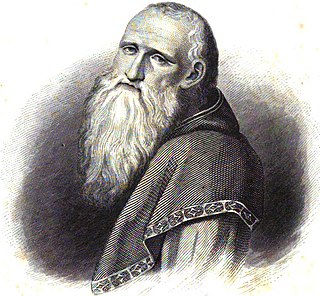
Bernardino Luini was a north Italian painter from Leonardo's circle during the High Renaissance. Both Luini and Giovanni Antonio Boltraffio were said to have worked with Leonardo directly; he was described as having taken "as much from Leonardo as his native roots enabled him to comprehend". Consequently, many of his works were attributed to Leonardo. He was known especially for his graceful female figures with elongated eyes, called Luinesque by Vladimir Nabokov.

Paolo Farinati was an Italian painter of the Mannerist style, active in mainly in his native Verona, but also in Mantua and Venice.

Vincenzo Foppa was an Italian painter from the Renaissance period. While few of his works survive, he was an esteemed and influential painter during his time and is considered the preeminent leader of the Early Lombard School. He spent his career working for the Sforza family, Dukes of Milan, in Pavia, as well as various other patrons throughout Lombardy and Liguria. He lived and worked in his native Brescia during his later years.
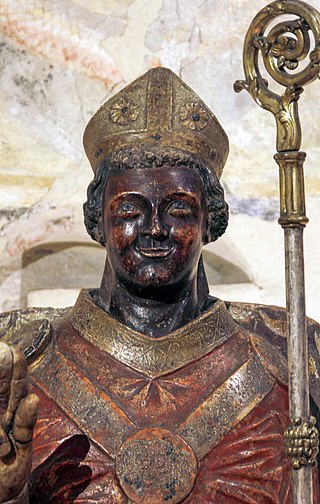
Zeno of Verona was an Afro-Italian Christian figure believed to have either served as Bishop of Verona or died as a martyr. He is venerated as a saint in the Catholic Church and the Orthodox Church.
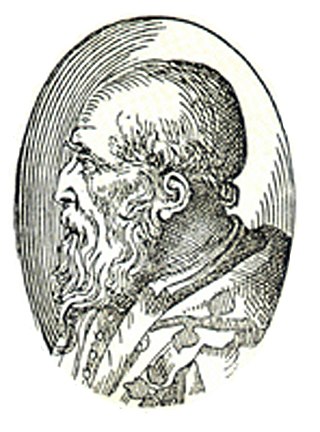
Michele Sanmicheli, sometimes also transcribed as Sammicheli, Sanmichele or Sammichele, was an Italian architect and urban planner who was a citizen of the Republic of Venice.

Sebastiano Ricci was an Italian Baroque painter of the late Baroque period in Venetian painting. About the same age as Piazzetta, and an elder contemporary of Tiepolo, he represents a late version of the vigorous and luminous Cortonesque style of grand manner fresco painting.

Bernardino India (1528–1590) was an Italian painter of the late Renaissance, born and mainly active in Verona.

Ottavio Amigoni was an Italian painter of the Baroque period, active in Brescia. He was trained by Antonio Gandini. Among his masterpieces is a large fresco about the life of Sant'Alberto in the Carmelite church of Brescia, painted with Gandino's son, Bernardino.
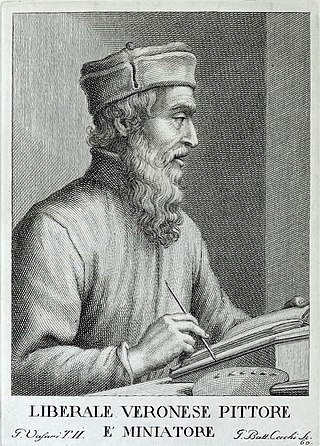
Liberale da Verona (1441–1526) was an Italian painter of the Renaissance period, active mainly in Verona.
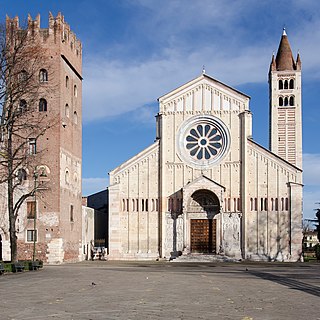
The Basilica di San Zeno is a minor basilica of Verona, northern Italy constructed between 967 and 1398 AD. Its fame rests partly on its Romanesque architecture and partly upon the tradition that its crypt was the place of the marriage of Shakespeare's Romeo and Juliet.

The chiesa di Sant'Anastasia, or the Basilica of Saint Anastasia is a church built by the Dominican Order in Verona, northern Italy. In Gothic style, it is the largest church in the city, located in its most ancient district, near the Ponte Pietra.

Veronese bell ringing is a style of ringing church bells that developed around Verona, Italy, from the eighteenth century. The bells are rung full circle, being held up by a rope and wheel until a note is required.

Zenone Veronese was an Italian painter of the Renaissance period. He is different but a near-contemporary of Michele da Verona.

Turone was an Italian architect, painter and illuminator, active in the Veronese area in the second half of the 14th century.
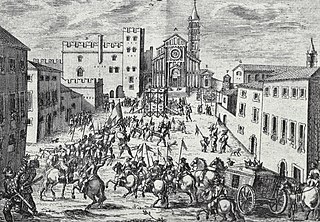
The Abbey of San Zeno was erected in the 9th century on the remains of a preexisting monastery, whose origins date back to the 4th century. Of the abbey, the abbey tower of San Zeno and several cloisters that are now part of the Basilica of San Zeno survive. It was very important both for the history of Verona and for the relations the German emperors had with Italy.
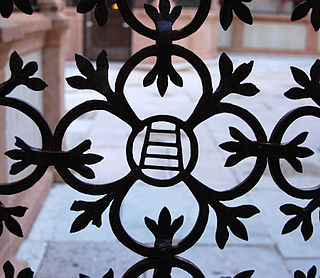
The monuments of Verona are a vast number of architecturally, archaeologically, historically, and artistically significant cultural assets that characterize the city of Verona. Precisely because of the richness of its monuments and the urban evolution that has developed seamlessly over the centuries, UNESCO declared the city a World Heritage Site in 2000.





















